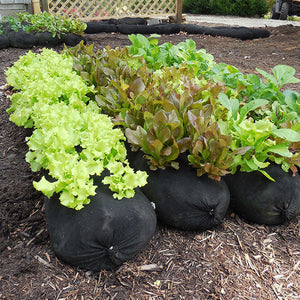This versatile vegetable in the Brassica Family is an excellent nutrient-dense crop option for the home gardener. Learn how to grow cauliflower and discover how this high-fiber cruciferous supports the digestive system and contributes to a healthy heart and balanced metabolism.
Cauliflower’s mild flavor lends well to a wide range of recipes, it is even a popular substitute for rice or wheat in low-carbohydrate diets. While the head of the cauliflower is most commonly consumed, the stems and leaves are also edible and can be added to soup or used similarly to cabbage.

Growing cauliflower in GardenSoxx® | Plant Family: Brassicaceae
Different Varieties of Cauliflower
With many different varieties of cauliflower to choose from, gardeners can make a selection based on head size, color and growing time to fit their preference. Here are a few to consider for your garden:
An excellent orange cauliflower for the home garden is the Cheddar variety. With less than 60 days to maturity, this quick-growing cultivar can be sown in spring or summer. Packed with nutrients, its vibrant color increases once it is cooked.
Offering high yields and consistent-sized heads, DePurple is, as its name suggests, a purple cauliflower variety popular among home and market gardeners.
For the impatient gardener, a variety like EarliSnow will mature in as little as 45 days, planted from seed. The heads are a consistent medium size but should be leaf-wrapped as they mature to retain their bright white coloring.
If you prefer a self-blanching variety that does not require the extra step of leaf-wrapping, the Twister Cauliflower is a great choice. This adaptable variety produces large, uniform heads that will mature in a little over 60 days from planting.
In less predictable growing zones, the weather-tolerant Amazing cauliflower variety is an ideal choice due to its tolerance and adaptability. At around 70 days to mature, this variety is also self-blanching and does very well even in hot weather.
Sometimes mistaken for broccoli, the Romanesco cauliflower cultivar is truly unique with its odd-shaped, spikey spiraled green curds. At over 110 days from seed to harvest, this variety takes longer to mature than most; but its sweet, nutty flavor lends well to a wide variety of culinary uses.
Nutritional Information For Cauliflower
Nutritional Facts - per 100/g
| Nutrient | Amount | % Daily Value |
|---|---|---|
| Calories | 25 | - |
| Total Fat | 0.3 g | - |
| Sodium | 30 mg | - |
| Potassium | 299 mg | - |
| Dietary Fiber | 2 g | - |
| Sugar | 1.9 g | - |
| Protein | 1.9 g | - |
| Vitamin C | - | 80% |
| Iron | - | 2% |
| Vitamin B6 | - | 10% |
| Magnesium | - | 3% |
| Calcium | - | 2% |
How to Grow Cauliflower in Your GardenSoxx®
Cooler weather is needed in order for cauliflower to form its head, so while the crop can be planted in early spring, it is an excellent fall crop as well. If planting in spring, seeds should be started indoors for a variety that has a bit of a shorter growing cycle (some varieties only take 50-60 days to produce a harvest). If planting a fall crop, you can sow seeds outdoors around mid-summer, planting them about 12 inches apart, in moist but well-draining soil.
Cauliflower Seed to Harvest Time: 80 - 100 days

How to Harvest Cauliflower
Once the head of the cauliflower grows to be about 3-4 inches in diameter, it can get discolored by too much sunlight and may turn bitter - so many gardeners will choose to “blanch” the cauliflower by enclosing it in its own leaves for about 10 days before it is ready to harvest. Once this process is complete, cut the cauliflower off its stem, along with the outer leaves.























































